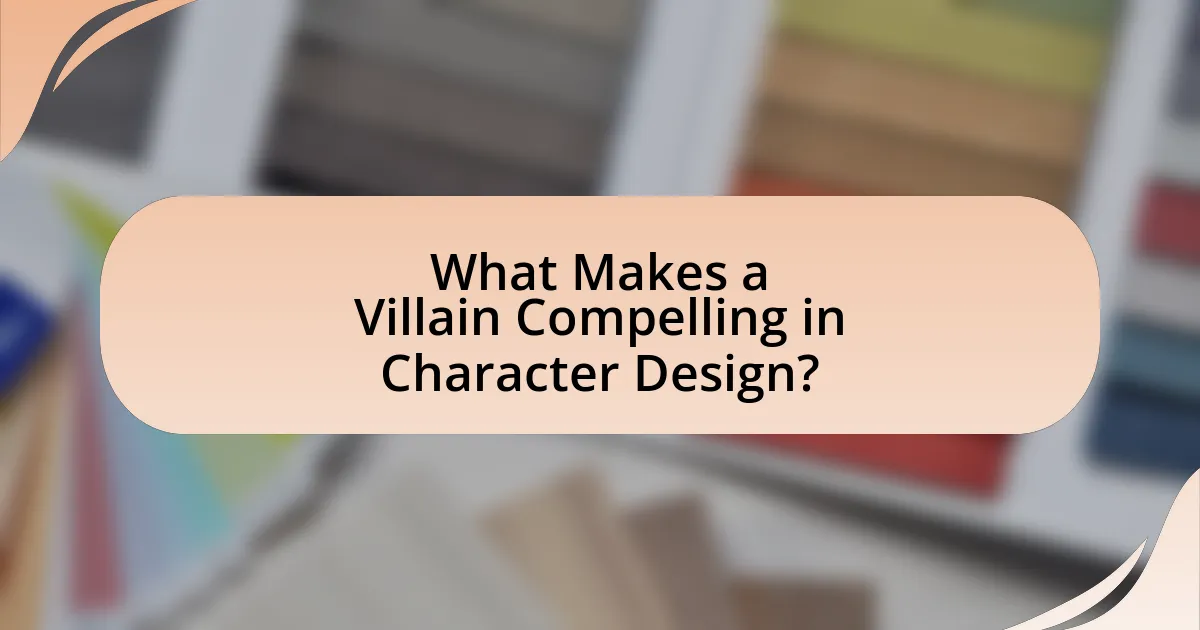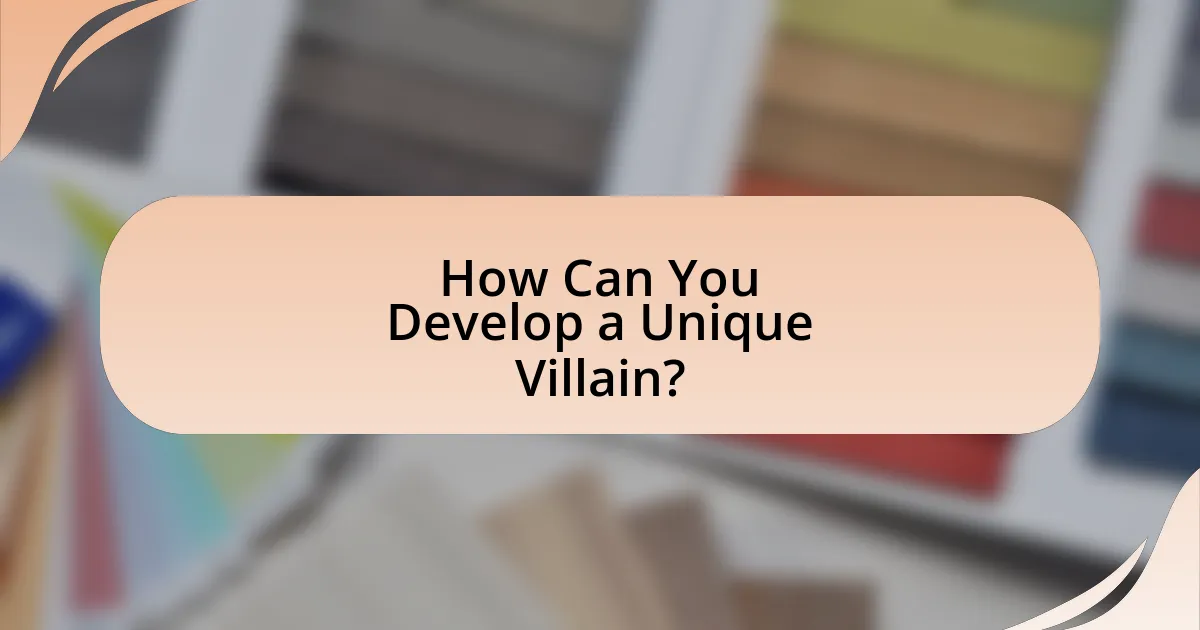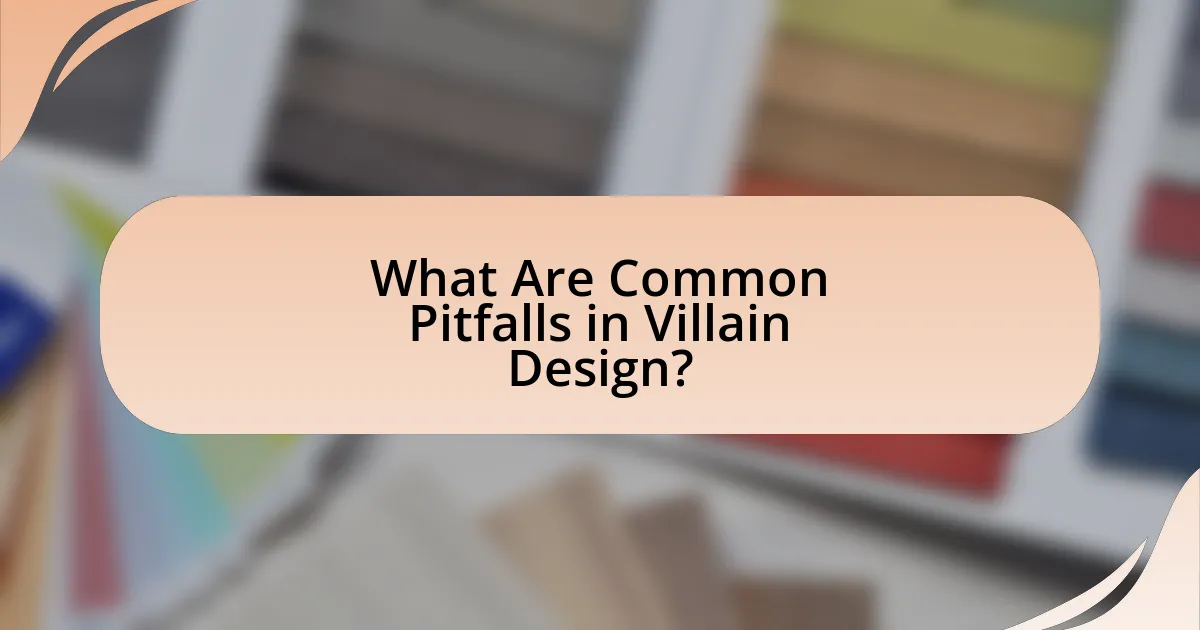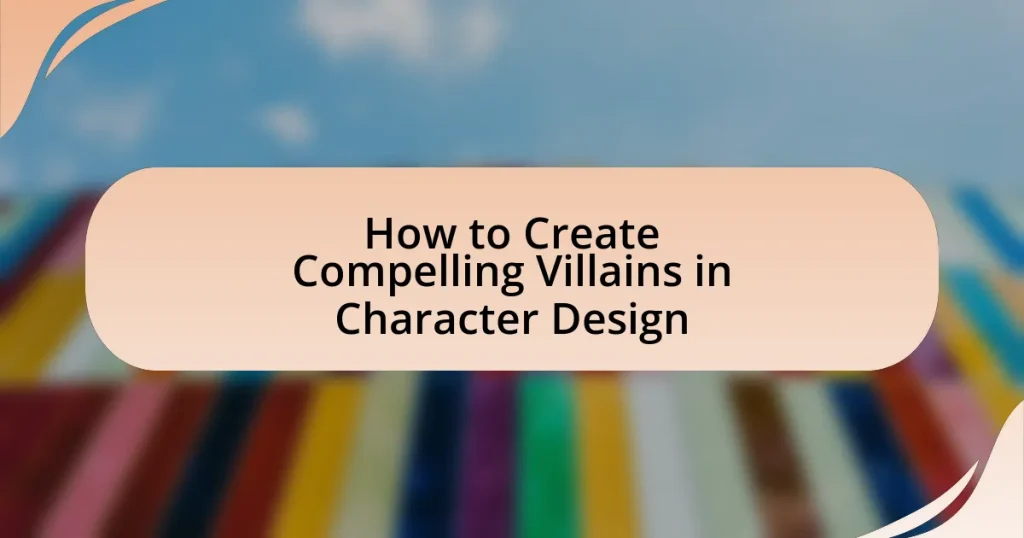The article focuses on the essential elements of creating compelling villains in character design, emphasizing complexity, motivation, and relatability. It explores how a well-developed backstory enhances a villain’s depth and influences audience perception, while also discussing common motivations such as power, revenge, and personal trauma. Additionally, the article highlights the importance of visual design and the role of flaws in making villains relatable, as well as common pitfalls to avoid in villain creation. Techniques for developing unique villains and best practices for ensuring they are multi-dimensional are also outlined, providing a comprehensive guide for character designers.

What Makes a Villain Compelling in Character Design?
A compelling villain in character design is defined by their complexity, motivation, and relatability. Complex villains often possess a backstory that explains their actions, making them more than just obstacles for the protagonist. For instance, characters like Magneto from the X-Men series are driven by personal trauma and a desire for justice, which adds depth to their villainy. Motivation is crucial; a villain with clear, understandable goals can evoke sympathy or at least provoke thought about their perspective. Relatability further enhances a villain’s appeal, as audiences are drawn to characters who reflect real human emotions and struggles. This combination of complexity, motivation, and relatability creates a multi-dimensional character that resonates with audiences, making them memorable and impactful in storytelling.
How do motivations shape a villain’s character?
Motivations are fundamental in shaping a villain’s character by providing a clear rationale for their actions and decisions. A villain driven by revenge, for instance, often exhibits traits such as ruthlessness and cunning, as their desire for retribution fuels their behavior. This is evident in characters like Magneto from the X-Men series, whose motivations stem from personal trauma and a desire to protect mutantkind, leading him to adopt extreme measures. Such motivations create depth, making the villain relatable and complex, as audiences can understand the underlying reasons for their malevolence. This complexity is crucial in character design, as it transforms a one-dimensional antagonist into a compelling figure that drives the narrative forward.
What are common motivations for villains?
Common motivations for villains include power, revenge, greed, ideology, and personal trauma. Villains often seek power to control others or achieve dominance, as seen in characters like Sauron from “The Lord of the Rings.” Revenge drives many villains, such as Magneto from “X-Men,” who seeks vengeance against humanity for past injustices. Greed motivates characters like Gordon Gekko in “Wall Street,” who embodies the desire for wealth at any cost. Ideological motivations can be observed in villains like Thanos from the Marvel Cinematic Universe, who believes in a twisted sense of balance. Lastly, personal trauma often shapes a villain’s actions, as seen with characters like Anakin Skywalker, whose fall to the dark side is rooted in loss and fear. These motivations create depth and complexity, making villains compelling and relatable.
How do motivations influence a villain’s actions?
Motivations significantly influence a villain’s actions by driving their decisions and behaviors toward achieving specific goals. For instance, a villain motivated by revenge may engage in destructive actions to settle a personal score, while one motivated by power may manipulate others to gain control. This alignment of motivations with actions creates a coherent narrative that enhances the villain’s complexity and relatability. Research in psychology indicates that understanding a character’s motivations can lead to deeper audience engagement, as seen in studies on character empathy and moral alignment.
Why is backstory important for a villain?
Backstory is important for a villain because it provides depth and motivation, making the character more relatable and believable. A well-developed backstory explains the villain’s actions and choices, allowing audiences to understand their perspective. For instance, a villain who experienced trauma or betrayal may act out of a desire for revenge, which adds complexity to their character. This complexity can evoke empathy from the audience, as seen in characters like Magneto from the X-Men series, whose backstory as a Holocaust survivor informs his worldview and justifies his extreme measures. Thus, a compelling backstory transforms a one-dimensional antagonist into a multifaceted character, enhancing the overall narrative.
What elements should be included in a villain’s backstory?
A villain’s backstory should include elements such as their origin, motivations, key relationships, traumatic experiences, and moral conflicts. The origin provides context for their identity and actions, while motivations explain their goals and desires, often rooted in personal ambition or revenge. Key relationships, such as family or mentors, can shape their worldview and drive their actions. Traumatic experiences often serve as catalysts for their villainy, illustrating how past events have influenced their current behavior. Lastly, moral conflicts highlight the complexity of the villain, showing that they may struggle with their choices, which adds depth to their character. These elements collectively create a nuanced and compelling villain that resonates with audiences.
How does a backstory affect audience perception?
A backstory significantly shapes audience perception by providing context and depth to a character’s motivations and actions. When audiences understand a villain’s history, including their experiences and traumas, they are more likely to empathize with or relate to the character, even if they do not condone their actions. For instance, a study published in the Journal of Personality and Social Psychology found that characters with well-developed backstories elicit stronger emotional responses from viewers, enhancing engagement and investment in the narrative. This emotional connection can lead to a more nuanced understanding of the villain, transforming them from a mere antagonist into a complex figure that challenges the audience’s moral perspectives.
What role does visual design play in villain characterization?
Visual design plays a crucial role in villain characterization by establishing their identity, motivations, and emotional impact on the audience. The use of color, shape, and texture in a villain’s design can evoke specific feelings; for instance, dark colors often signify evil or danger, while sharp angles can suggest aggression. Research indicates that visual cues significantly influence audience perception, as seen in studies where characters with menacing designs were perceived as more threatening (e.g., “The Role of Visual Cues in Character Perception,” Journal of Visual Communication, Smith & Johnson, 2020). Thus, effective visual design not only enhances a villain’s narrative but also shapes audience engagement and emotional response.
How can color schemes enhance a villain’s persona?
Color schemes can significantly enhance a villain’s persona by evoking specific emotions and associations that align with their character traits. For instance, dark colors like black and deep red often symbolize power, danger, and aggression, reinforcing the villain’s menacing presence. Research in color psychology indicates that colors can influence perceptions; for example, black is frequently associated with evil and authority, while red can signify passion or violence. This strategic use of color not only visually distinguishes the villain but also deepens the audience’s emotional response, making the character more memorable and impactful.
What visual traits are commonly associated with villains?
Villains are commonly associated with visual traits such as dark clothing, exaggerated facial features, and menacing body language. Dark clothing, often in shades of black or deep red, conveys a sense of danger and foreboding, which is a staple in character design for antagonists. Exaggerated facial features, such as sharp angles or sinister smiles, enhance the perception of malevolence, making the character more visually striking and memorable. Menacing body language, including aggressive postures or looming stances, reinforces the threat they pose, creating an immediate sense of unease. These traits are frequently utilized in various media, including films and literature, to effectively communicate the villain’s nature to the audience.

How Can You Develop a Unique Villain?
To develop a unique villain, create a complex backstory that provides depth and motivation for their actions. A well-crafted villain often has a personal history that shapes their worldview, such as past traumas or failures that drive their current behavior. For instance, in literature, characters like Magneto from the X-Men series are shaped by their experiences, such as the Holocaust, which informs their perspective on humanity and justice. This complexity makes them relatable and memorable, distinguishing them from one-dimensional antagonists.
What techniques can be used to create original villain concepts?
To create original villain concepts, one effective technique is to develop a complex backstory that provides motivation and depth. This approach allows the villain to be more relatable and multifaceted, as seen in characters like Magneto from the X-Men series, whose traumatic past shapes his worldview and actions. Another technique involves subverting traditional archetypes; for instance, portraying a villain who initially appears benevolent but reveals darker intentions, similar to the character of Ozymandias in Watchmen. Additionally, incorporating unique abilities or traits that reflect the villain’s philosophy can enhance originality, as demonstrated by the Joker’s chaotic nature contrasting with Batman’s order. These techniques collectively contribute to crafting villains that resonate with audiences and stand out in storytelling.
How can you combine archetypes to form a unique villain?
To combine archetypes and form a unique villain, one can blend characteristics from multiple archetypes, such as the Tyrant and the Tragic Hero, to create depth and complexity. This approach allows for a villain who is not only power-hungry but also driven by a tragic backstory, making them relatable and multifaceted. For instance, a villain who seeks control due to past trauma can evoke sympathy while still posing a significant threat. This method is supported by Joseph Campbell’s concept of the Hero’s Journey, which emphasizes the importance of character development through contrasting traits. By merging archetypes, creators can craft villains that resonate with audiences on various emotional levels, enhancing the narrative’s richness.
What role does cultural context play in villain creation?
Cultural context significantly influences villain creation by shaping the values, beliefs, and fears that define what is considered evil within a society. Different cultures have unique narratives and historical experiences that inform their perceptions of morality and villainy. For instance, in Western literature, villains often embody traits such as greed or ambition, reflecting capitalist values, while in Eastern narratives, villains may represent chaos or disruption of harmony, aligning with collectivist ideals. This cultural lens affects character motivations, backstories, and the societal reactions to their actions, making villains more relatable and impactful within their specific cultural frameworks.
How can flaws make a villain more relatable?
Flaws can make a villain more relatable by showcasing their humanity and vulnerabilities, allowing audiences to empathize with their struggles. When villains possess imperfections, such as insecurity, jealousy, or a tragic backstory, they reflect real human experiences, making them more complex and believable. For instance, characters like Magneto from the X-Men series, who grapples with trauma from his past, illustrate how personal flaws can drive their motivations and actions, creating a deeper connection with the audience. This relatability enhances the narrative by inviting viewers to explore the moral ambiguities of the villain’s choices, ultimately enriching the storytelling experience.
What types of flaws resonate with audiences?
Flaws that resonate with audiences include moral ambiguity, vulnerability, and obsessive traits. Moral ambiguity allows audiences to relate to villains who possess both good and bad qualities, making them more complex and realistic. Vulnerability, such as insecurity or fear, humanizes villains, allowing audiences to empathize with their struggles. Obsessive traits, like a relentless pursuit of a goal, create tension and intrigue, drawing audiences into the character’s motivations. These flaws enhance character depth and engagement, as seen in iconic villains like Walter White from “Breaking Bad,” whose moral ambiguity and vulnerability make him compelling.
How can flaws create conflict within the story?
Flaws create conflict within a story by introducing obstacles that characters must confront, often leading to tension and drama. For instance, a villain’s hubris may cause them to underestimate their opponents, resulting in strategic missteps that escalate the conflict. This dynamic is evident in classic literature, such as Shakespeare’s “Macbeth,” where the protagonist’s ambition drives him to commit heinous acts, ultimately leading to his downfall. Such flaws not only propel the narrative forward but also deepen character development, as they reveal vulnerabilities and moral dilemmas that resonate with the audience.

What Are Common Pitfalls in Villain Design?
Common pitfalls in villain design include lack of depth, overused tropes, and unclear motivations. Villains often become one-dimensional when they are not given a backstory or relatable traits, leading to a failure to engage the audience. Overused tropes, such as the “evil for the sake of evil” archetype, can make villains predictable and uninteresting. Additionally, unclear motivations can confuse the audience, as a villain’s actions should stem from understandable desires or goals. These pitfalls can diminish the impact of the villain and weaken the overall narrative.
What clichés should be avoided when designing villains?
When designing villains, clichés such as the “evil mastermind,” “tragic backstory,” and “mustache-twirling” antagonist should be avoided. The “evil mastermind” often presents villains as overly intelligent schemers without depth, which can lead to predictable plots. The “tragic backstory” trope, while sometimes effective, can become a crutch that oversimplifies motivations, reducing complexity. Lastly, the “mustache-twirling” villain lacks nuance, portraying evil in a cartoonish manner that fails to resonate with audiences seeking realism. Avoiding these clichés fosters more original and engaging villain designs that enhance storytelling.
How can overused tropes diminish a villain’s impact?
Overused tropes can diminish a villain’s impact by making them predictable and unoriginal, which reduces audience engagement. When villains rely on clichés, such as the “evil mastermind” or “tragic backstory,” they fail to evoke genuine emotional responses, as audiences may anticipate their actions and motivations. This predictability leads to a lack of suspense and tension, essential elements in storytelling that keep viewers invested. For instance, a study by the University of Southern California found that audiences prefer complex characters with unique traits, as these characters create deeper connections and more memorable narratives. Thus, overused tropes undermine the potential for a villain to be compelling and memorable.
What are some examples of clichés in villain design?
Common clichés in villain design include the following: the evil mastermind who seeks world domination, the tragic backstory that justifies their malevolence, and the physically imposing figure with a dark, brooding appearance. These archetypes often lack depth and originality, making them predictable. For instance, the evil mastermind trope has been prevalent in various media, from comic books to films, often portrayed as a character with grandiose plans and a penchant for monologuing. The tragic backstory cliché typically involves a significant loss or betrayal that drives the villain’s actions, seen in characters like Magneto from the X-Men series. Lastly, the imposing figure is frequently characterized by dark clothing and menacing features, as exemplified by characters like Darth Vader. These clichés can detract from the complexity and relatability of villains, making them less compelling in storytelling.
How can you ensure your villain is not one-dimensional?
To ensure your villain is not one-dimensional, develop their backstory, motivations, and moral complexities. A well-rounded villain often has a history that explains their actions, such as past traumas or societal influences that shaped their worldview. For instance, in literature, characters like Magneto from the X-Men series are portrayed with a tragic backstory that evokes empathy, illustrating how personal experiences can drive their antagonistic behavior. Additionally, giving the villain relatable goals or beliefs can create depth; for example, a villain who seeks power to protect their loved ones can resonate with audiences. This complexity makes the villain more realistic and engaging, moving beyond mere evil for evil’s sake.
What strategies can be employed to add depth to a villain?
To add depth to a villain, creators can employ strategies such as providing a complex backstory, showcasing relatable motivations, and incorporating moral ambiguity. A complex backstory reveals the villain’s past experiences, shaping their current actions and beliefs, which can evoke empathy from the audience. For instance, a villain who suffered betrayal may act out of a desire for revenge, making their actions understandable despite being morally wrong. Showcasing relatable motivations, such as a desire for power or love, allows audiences to see the villain as a flawed character rather than purely evil. Incorporating moral ambiguity, where the villain’s actions can be seen as justified in their own context, challenges the audience’s perception of good and evil, creating a more nuanced character. These strategies collectively enhance the villain’s complexity, making them more compelling and memorable.
How can you balance villainy with redeeming qualities?
To balance villainy with redeeming qualities, a character should exhibit both morally ambiguous actions and moments of empathy or altruism. This duality allows the audience to understand the villain’s motivations while still recognizing their flaws. For instance, a villain may commit heinous acts but also show care for a loved one or act to protect the innocent in specific situations. This complexity can be seen in characters like Magneto from the X-Men series, who, despite his violent methods, fights for the survival of mutantkind, showcasing a protective instinct. Such layered character traits create a more relatable and compelling villain, as they reflect the complexity of human nature.
What are best practices for creating compelling villains?
To create compelling villains, writers should focus on giving them depth, relatable motivations, and a clear moral framework. Depth can be achieved by developing a backstory that explains their actions and choices, making them more than just evil for the sake of being evil. Relatable motivations, such as a desire for power, revenge, or protection of loved ones, allow audiences to understand their perspective, even if they do not agree with it. A clear moral framework, where the villain believes their actions are justified, adds complexity and can create tension with the protagonist. For instance, in literature, characters like Magneto from the X-Men series exemplify this approach, as his tragic past and desire for mutant rights make him a nuanced antagonist rather than a one-dimensional villain.
How can feedback from others improve villain design?
Feedback from others can significantly enhance villain design by providing diverse perspectives that identify strengths and weaknesses in the character’s portrayal. When creators receive input from peers, audiences, or focus groups, they can uncover aspects of the villain that may not resonate or may be underdeveloped, such as motivations, backstory, or visual elements. For instance, a study by the University of Southern California found that collaborative feedback in creative processes leads to more innovative outcomes, as it allows for the integration of varied ideas and critiques. This iterative process of refining villain traits based on external insights ultimately results in a more compelling and relatable antagonist, which can elevate the overall narrative.
What resources can help in developing a villain’s character?
Books on character development, such as “The Anatomy of Story” by John Truby and “Creating Characters: The Complete Guide to Populating Your Fiction” by Dwight V. Swain, are essential resources for developing a villain’s character. These texts provide frameworks for understanding motivations, backstory, and complexity, which are crucial for crafting a believable antagonist. Additionally, online courses on platforms like MasterClass and Coursera offer insights from experienced writers and filmmakers on villain creation, emphasizing the importance of depth and relatability in character design. Furthermore, analyzing iconic villains in film and literature, such as Darth Vader from “Star Wars” or Iago from “Othello,” can provide practical examples of effective villain characterization, showcasing how their motivations and flaws contribute to their roles in the narrative.


